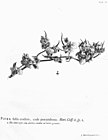Note: This is a project under development. The articles on this wiki are just being initiated and broadly incomplete. You can Help creating new pages.
Peperomia pellucida - Toyakandha
Toyakandha belongs to the family Piperaceae. It comprises about a dozen genera and around 3000 species. The genus Peperomia represents nearly half of the Piperaceae with the genus Piper making the bulk of the rest.
Contents
[hide]- 1 Uses
- 2 Parts Used
- 3 Chemical Composition
- 4 Common names
- 5 Properties
- 6 Habit
- 7 Identification
- 8 List of Ayurvedic medicine in which the herb is used
- 9 Where to get the saplings
- 10 Mode of Propagation
- 11 How to plant/cultivate
- 12 Commonly seen growing in areas
- 13 Photo Gallery
- 14 References
- 15 External Links
Uses
Eye inflammation, Prostate problems, High blood pressure, Arthritis, Gout, Skin boils, Wounds, Diarrhea, Sore throats, Abscesses, Headache, Abdominal pains, Renal problems, Mental excitement disorder.
Parts Used
Chemical Composition
Phytol (37.88%) was the major compound in the plant extract followed by 2-Naphthalenol, decahydro- (26.20%), Hexadecanoic acid, methyl ester (18.31%) and 9,12-Octadecadienoic acid (Z,Z)-, methyl ester (17.61%).[1]
Common names
| Language | Common name |
|---|---|
| Kannada | |
| Hindi | |
| Malayalam | Mashitandu chedi |
| Tamil | |
| Telugu | |
| Marathi | NA |
| Gujarathi | NA |
| Punjabi | NA |
| Kashmiri | NA |
| Sanskrit | Toyakandha, Varshabhoo |
| English | Shiny Bush, Slate pencil plant |
Properties
Reference: Dravya - Substance, Rasa - Taste, Guna - Qualities, Veerya - Potency, Vipaka - Post-digesion effect, Karma - Pharmacological activity, Prabhava - Therepeutics.
Dravya
Rasa
Tikta (Bitter), Kashaya (Astringent)
Guna
Laghu (Light), Ruksha (Dry), Tikshna (Sharp)
Veerya
Ushna (Hot)
Vipaka
Katu (Pungent)
Karma
Kapha, Vata
Prabhava
Habit
Identification
Leaf
| Kind | Shape | Feature |
|---|---|---|
| Simple | Heart shaped | Fleshy leaves are heart shaped, shiny light green, 1.5-4 cm long, 1-3.3 cm wide |
Flower
| Type | Size | Color and composition | Stamen | More information |
|---|---|---|---|---|
| Bisexual | 3-6 cm long | Yellow | 5 | It has very small bi-sexual flowers growing in the form of cord-like spikes |
Fruit
| Type | Size | Mass | Appearance | Seeds | More information |
|---|---|---|---|---|---|
| Round to oblong | 7–10 mm | The fruits are also very small, round to oblong, ridged, first green later black | With hooked hairs | Single | {{{6}}} |
Other features
List of Ayurvedic medicine in which the herb is used
Where to get the saplings
Mode of Propagation
How to plant/cultivate
The plant requires a minimum temperature of 10°c and Prefers a well-drained, humus-rich soil.[3]
Commonly seen growing in areas
Damp places, Wet thickets, Mixed forest.
Photo Gallery
References
External Links
- Ayurvedic Herbs known to be helpful to treat Eye inflammation
- Ayurvedic Herbs known to be helpful to treat Prostate problems
- Ayurvedic Herbs known to be helpful to treat High blood pressure
- Ayurvedic Herbs known to be helpful to treat Arthritis
- Ayurvedic Herbs known to be helpful to treat Gout
- Ayurvedic Herbs known to be helpful to treat Skin boils
- Ayurvedic Herbs known to be helpful to treat Wounds
- Ayurvedic Herbs known to be helpful to treat Diarrhea
- Ayurvedic Herbs known to be helpful to treat Sore throats
- Ayurvedic Herbs known to be helpful to treat Abscesses
- Ayurvedic Herbs known to be helpful to treat Headache
- Ayurvedic Herbs known to be helpful to treat Abdominal pains
- Ayurvedic Herbs known to be helpful to treat Renal problems
- Ayurvedic Herbs known to be helpful to treat Mental excitement disorder
- Herbs with Dried folaige used in medicine
- Herbs with Whole herb used in medicine
- Herbs with common name in Malayalam
- Herbs with common name in Sanskrit
- Herbs with common name in English
- Habit - Annual plant
- Index of Plants which can be propagated by Seeds
- Index of Plants which can be propagated by Cuttings
- Herbs that are commonly seen in the region of Damp places
- Herbs that are commonly seen in the region of Wet thickets
- Herbs that are commonly seen in the region of Mixed forest
- Herbs
- Piperaceae






